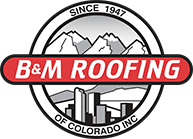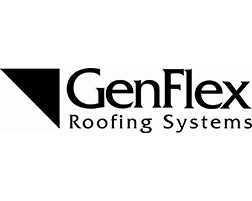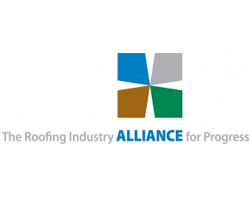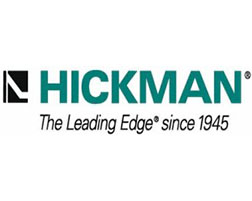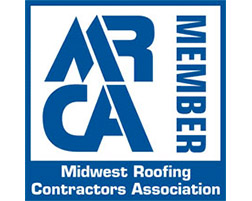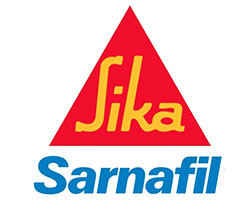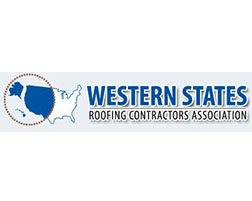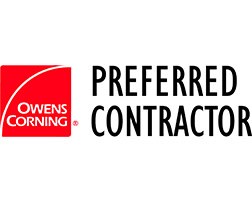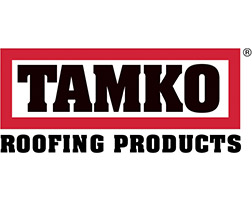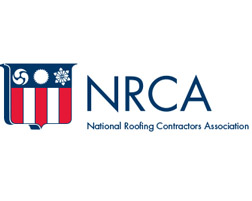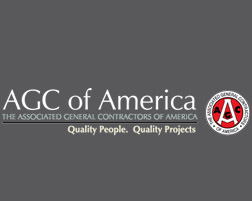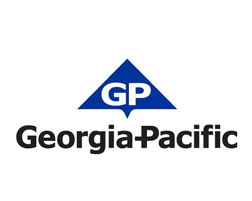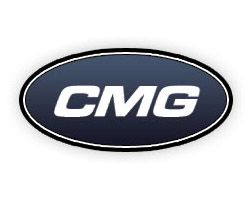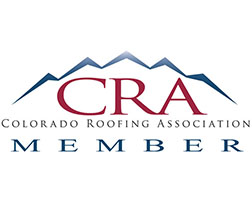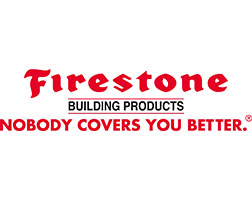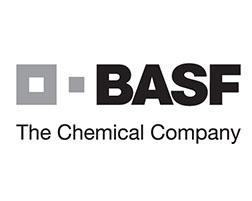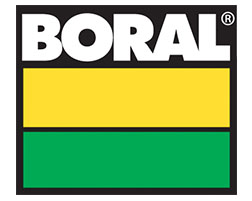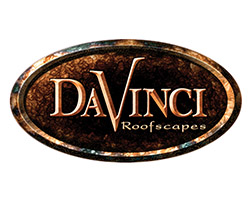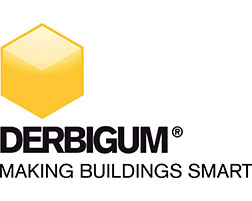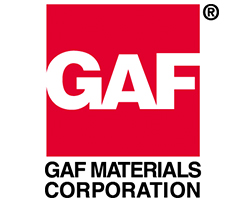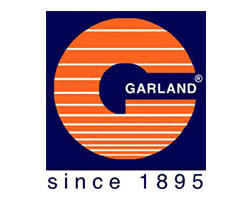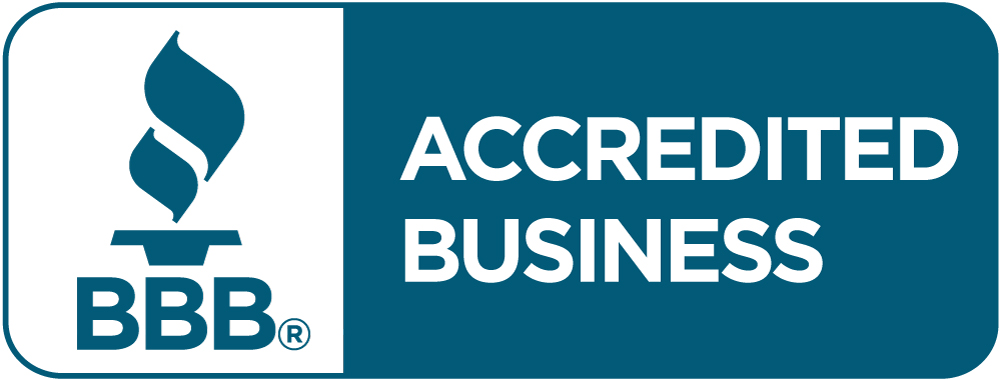Longest Lasting Roof Type
When it comes to investing in your property, few decisions are as significant as choosing the right roofing material. Not only does your roof safeguard your home or business from the elements, but it also plays a pivotal role in your property’s overall aesthetics and value. Among the many options available, one question looms large: What is the longest lasting roof type?
Every property is unique, and its roofing requirements reflect that. The team of B&M Roofing takes the time to assess your property’s specific needs, considering factors such as climate, architectural style, budget constraints, and long-term goals. Our experts offer tailored recommendations that align with your individual preferences and requirements.
In this article, we’ll explore what is the longest lasting and most durable roof type and material that can stand the test of time.
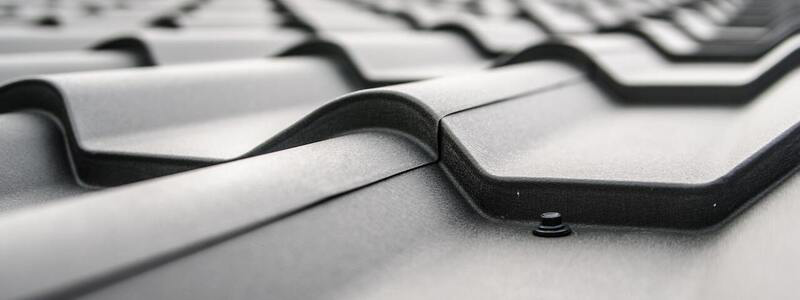
The Quest for the Longest Lasting Roof Type
Roofing materials vary widely in terms of lifespan, durability, and resilience. The longest-lasting roof type is one that strikes a harmonious balance between all these factors, providing you with decades of protection without constant maintenance or repairs. While there are several contenders, one material consistently stands out as the front-runner in terms of longevity and strength: slate roofing.
Slate Roofing: A Timeless Triumph
When it comes to a roof that’s not only built to last but also exudes an air of timeless elegance, slate roofing takes the crown. Crafted from natural stone, slate shingles offer a remarkable lifespan that can extend well beyond a century. This makes them a compelling choice for home and business owners seeking a roofing solution that doesn’t just provide shelter but tells a story of enduring quality.
What Makes Slate Roofs Last So Long?
The secret to the remarkable longevity of slate roofs lies in the material’s exceptional properties. Slate is a metamorphic rock formed from layers of sedimentary rock subjected to immense pressure and heat over time. This unique formation process results in incredibly dense slate, resistant to water absorption and impervious to temperature fluctuations. As a result, slate shingles maintain their structural integrity and appearance for decades, if not centuries.
The Perks of Opting for Slate
- Unmatched durability: Slate’s durability is practically unparalleled. It can withstand harsh weather conditions, including heavy rain, hail, snow, and high winds, without showing signs of wear or deterioration. A roof made of good slate installed properly on a strong support structure is common to last a couple of centuries or even more.
- Low maintenance: Unlike many other roofing materials that require frequent repairs or replacement, slate roofs demand minimal maintenance. The general idea is set it and forget it. Their resistance to water and other elements means you won’t have to worry about rot, mold, or other common roofing issues.
- Aesthetic appeal: Slate roofing adds an undeniable aesthetic charm to any structure beyond its practical benefits. Its natural, earthy tones and unique texture can enhance the architectural beauty of your home or business.
- Eco-friendly choice: Slate is a natural material that doesn’t require chemical treatments or manufacturing processes. Choosing slate is a sustainable choice that contributes to reducing your environmental footprint.
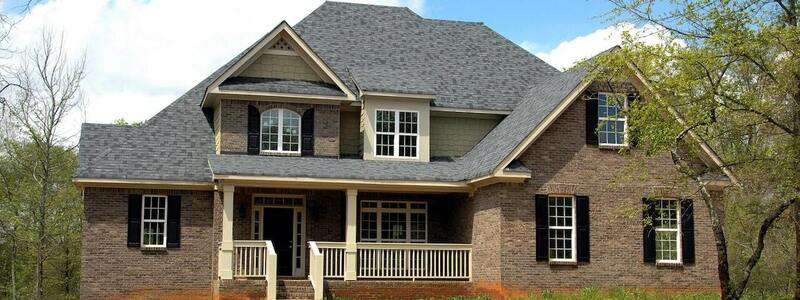
The Strength of the Alternatives
Selecting the suitable roofing material involves more than just aesthetic considerations. The decision can impact your property’s integrity, longevity, and value. When longevity is paramount, slate roofing emerges as the undisputed champion. Its innate durability, resistance to the elements, and timeless beauty make it an investment that pays dividends for generations. However, the alternatives, such as metal, concrete, and clay tile roofing, also offer impressive lifespans and unique benefits.
Metal Roofing: Enduring Excellence
Metal roofing has earned its reputation for durability by being an exceptional choice for homeowners and business owners seeking a long-lasting roofing solution. Though it feels like a modern solution, it has been around for centuries. The grayish rooftops of Paris get their color from zinc sheets first installed in the 1800s. The green color on many famous church domes is testimony to the theoretical conclusion that copper roofs can last 1000 years! And what other proud proof of copper sheet longevity than the Statue of Liberty itself?
This roofing category includes various metals, such as steel, copper and sometimes aluminum, each offering its unique benefits. Metal roofs typically provide a lifespan ranging from 40 to 70 years, contingent on factors like the specific material used and the level of maintenance upheld.
Why Metal Roofs Shine?
- Weather resilience: Metal roofs are engineered to withstand various weather conditions. They effortlessly shed snow, resist rainwater penetration, and endure high winds. This resilience makes them an excellent option for regions with extreme weather patterns.
- Durability: Metals like steel copper and aluminum possess inherent strength, ensuring that metal roofs hold up against impacts from hail, falling debris, and other potential hazards.
- Minimal maintenance: One of the key advantages of metal roofing is its low maintenance requirement. Metal roofs remain largely unaffected by these common issues, unlike materials that may succumb to rot, pests, or decay over time.
- Energy efficiency: Metal roofs often incorporate reflective coatings and various insulating layers that help reflect sunlight and heat away from the building, contributing to better energy efficiency and potential utility savings.
Concrete Tile Roofing: The Longevity of Concrete
Concrete tile roofing is a steadfast choice when longevity is a top priority. These tiles are known to endure for approximately 50 to 100 years, making them an investment that offers lasting protection. Concrete tiles are fashioned from a mixture of sand, water, and cement, which is then molded into shapes and cured to create robust roofing material.
Why Concrete Tiles Endure?
- Fire and pest resistance: Concrete tiles are non-combustible, rendering them highly fire-resistant. Additionally, their composition deters pests and rodents, enhancing the overall longevity of the roof.
- Color retention: These tiles are often pigmented with durable color coatings, which means they retain their appearance over the years, even in the face of constant exposure to the elements.
- Climate adaptability: Concrete tiles are engineered to withstand diverse climates. They can handle freeze-thaw cycles without cracking, crucial for regions prone to temperature fluctuations.
Clay Tile Roofing: The Classic Choice
Clay tile roofing carries an air of timelessness, dating back 5,000 years to glazed earthenware rooftops in China, and elegance that few other materials can match. Beyond its aesthetic allure, clay tile roofing boasts an impressive lifespan of 75 to 100 years or even more, making it a choice that resonates with history and longevity. In the quest for the longest lasting roof type, clay tile roofing is a strong candidate.
The Strengths of Clay Tiles
- Distinct aesthetic: The warm, earthy tones of clay tiles contribute to a unique Mediterranean or Spanish architectural style that enhances the visual appeal of any property.
- Weather endurance: Clay tiles are naturally resistant to extreme weather conditions, including UV radiation, high winds, and heavy rainfall.
- Fire resistance: Similar to concrete tiles, clay tiles are fire-resistant, which can provide peace of mind for homeowners concerned about fire hazards.
- Eco-friendly: Using natural clay and the absence of synthetic materials make clay tile roofing an environmentally friendly choice.
Asphalt Shingles: A Balance of Affordability and Durability
Asphalt shingles are a popular choice for their balance between affordability and durability. While they might not match the longevity of slate or concrete tiles, high-quality asphalt shingles can still offer a respectable lifespan of around 20 to 30 years.
The Benefits of Asphalt Shingles
- Cost-effectiveness: Asphalt shingles are often more budget-friendly than other roofing materials, making them an accessible choice for homeowners seeking durability without breaking the bank.
- Variety: These shingles come in a wide range of colors, styles, and textures, allowing you to find a look that complements your property’s aesthetics.
- Ease of installation and repairs: Asphalt shingles are relatively lightweight and easy to install or replace, saving labor costs during installation and any necessary repairs.
- Weather resistance: High-quality asphalt shingles are designed to withstand various weather conditions, including moderate wind and rain.
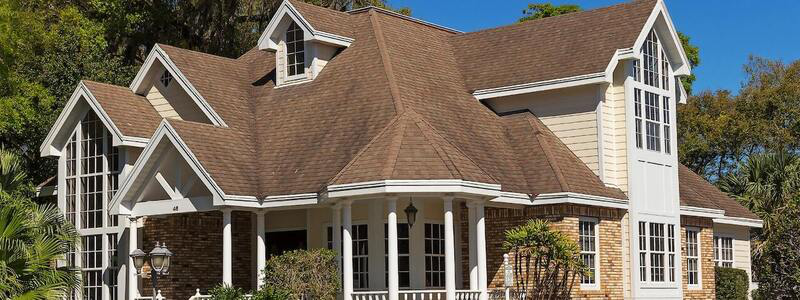
Longest Lasting Roof Type – B&M Roofing
Different roofing materials come with distinct advantages and potential drawbacks. B&M Roofing’s professionals are well-versed in the strengths and weaknesses of each material, enabling them to guide you toward the most suitable option based on your desired lifespan, aesthetic preferences, and maintenance expectations.
As you weigh your options, remember that a roof is more than just a protective covering; it’s a statement of durability, elegance, and longevity. Whether you’re looking to add character to your home or safeguard your business, the longest-lasting roof type will stand as a testament to your wise choice for years to come.
Winter Roof Repair Tips
Winter is a season of beauty and tranquility, but it can also be a time of challenges for homeowners, especially when it comes to roof maintenance. As temperatures drop and snow accumulates, roofs become more vulnerable to damage, leaks, and wear. The importance of proper care and timely repair cannot be overstated, as neglecting these aspects can lead to costly damages and safety hazards.
At B&M Roofing, we understand the unique challenges that winter brings to residential and commercial roofing. That’s why we’ve compiled a comprehensive guide to Winter Roof Repair Tips to help you navigate this season with confidence. From locating leaks to fixing worn sealants, our expert advice will keep your roof in optimal condition, ensuring warmth and safety for your family or business.
In the following sections, we’ll explore eight of our best Winter Roof Repair Tips that will guide you through the essential steps of winter roof maintenance. Whether you’re a seasoned homeowner or new to the responsibilities of property care, these tips will empower you to take control of your roof’s health during the cold months.
Remember, while these tips are designed to assist you with minor repairs and inspections, some issues may require professional intervention. B&M Roofing is always here to provide expert services tailored to your specific needs. Let’s dive into these Winter Roof Repair Tips and prepare your roof for the season ahead!
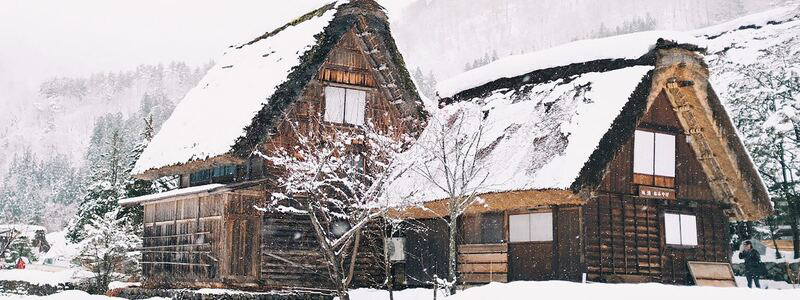
Finding the Leak
Winter weather can be harsh on your roof, leading to unexpected leaks that may cause water stains on your attic ceiling or even dripping from above. Finding the leak is the first and most crucial step in our Winter Roof Repair Tips, as identifying the source of the problem allows for targeted and effective repairs.
Signs of a Leak:
- Water stains on walls or ceilings.
- Dripping sounds or visible moisture.
- A slight draft or cold spot in a specific area.
Locating the Leak Inside:
- Inspect the part of your roof that is uphill from the stains.
- Look for roof penetrations, missing shingles, or other abnormalities.
- If you have access to your attic, locate the leak based on stains and mold on the walls.
Locating the Leak Outside:
- Cautiously inspect the roof from the outside, looking for damaged or missing shingles.
- Check for cracks or breaks around chimneys, vents, and other roof appendages.
- Consider using binoculars for a closer look without risking safety on a slippery roof.
When to Call a Professional:
- If the leak is extensive or the source is unclear.
- If you are uncomfortable or unable to safely inspect the roof yourself.
- If the leak persists after attempting a DIY fix.
Winter roof repair can be challenging, and locating a leak might require patience and careful observation. However, finding the leak is essential to prevent further damage and ensure the effectiveness of subsequent repairs. If you’re unsure or need professional assistance, don’t hesitate to contact B&M Roofing. Our experienced team is equipped to handle all your winter roof repair needs, ensuring that your home stays warm and dry throughout the season.
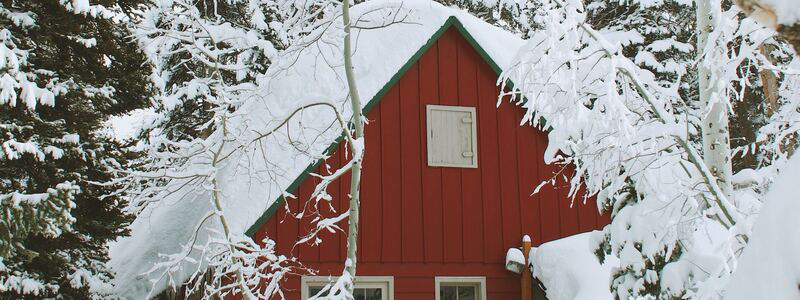
Fixing Plumbing Vent Boots
One of the common culprits behind roof leaks, especially during winter, is the plumbing vent boots. These essential components can become damaged over time, leading to unwanted moisture intrusion. In our Winter Roof Repair Tips, we’ll guide you through the process of inspecting and fixing plumbing vent boots to ensure a leak-free roof.
Understanding Plumbing Vent Boots:
- Plumbing vent boots are installed around plumbing vents, sealing the gap between the vent and the roof.
- They consist of a plastic base, metal top, and rubber boot surrounding the pipe.
- Damage to any of these parts can lead to leaks.
Inspecting the Vent Boots:
- Check the plastic bases for cracks or broken seams.
- Examine the rubber boot surrounding the pipe for tears or wear.
- Look for loose or missing nails at the base.
Repairing or Replacing Vent Boots:
- If the boot is in good shape but nails are loose, replace them with rubber-washer screws.
- If any part of the vent boot is broken or damaged, purchase a new plumbing vent boot.
- Follow the manufacturer’s instructions for installation, or consider hiring a professional if you’re unsure.
Safety Considerations:
- Always use caution when working on the roof, especially in winter when surfaces may be slippery.
Consider using a roof harness or working with a partner for added safety.
Fixing plumbing vent boots is a vital part of winter roof maintenance. While some repairs can be done on your own, don’t hesitate to reach out to B&M Roofing if the task seems too complex or if you prefer professional assistance. Our team is skilled in all aspects of roof repair, including plumbing vent boots, and we’re here to ensure your roof remains secure and leak-free all winter long.
Fixing a Leaky Chimney
Chimneys add character and warmth to a home, but they can also be a source of leaks, particularly during the harsh winter months. The flashing around brick chimneys is often susceptible to rust and damage, leading to unwanted water intrusion. In this section of our Winter Roof Repair Tips, we’ll explore how to identify and fix a leaky chimney, ensuring a cozy and dry winter season.
Identifying Chimney Leaks:
- Look for water stains or dampness around the chimney area inside the house.
- Inspect the flashing around the chimney for rust, cracks, or detachment.
- Check the mortar and bricks for signs of wear or damage.
Quick Fixes for Leaky Chimneys:
- Slip new flashing under the old rusted flashing to drive water downhill temporarily.
- Apply a waterproof sealant to small cracks or gaps as a short-term solution.
Long-Term Solutions:
- Replace the flashing altogether, ensuring proper installation and sealing.
- Consider repointing or rebuilding the chimney if the mortar or bricks are severely damaged.
- Hire a professional roofing contractor like B&M Roofing for a thorough inspection and repair.
Safety and Considerations:
- Working around chimneys can be complex and requires proper tools and safety measures.
- If you’re unsure about the repair process, it’s best to consult with a professional.
Chimneys are more than just aesthetic features; they play a vital role in venting your home. Ensuring their integrity is essential for both safety and comfort. While some minor repairs can be handled independently, a leaky chimney often requires professional attention. B&M Roofing’s experienced team is ready to assist with all your chimney repair needs, providing expert solutions that last beyond the winter season.
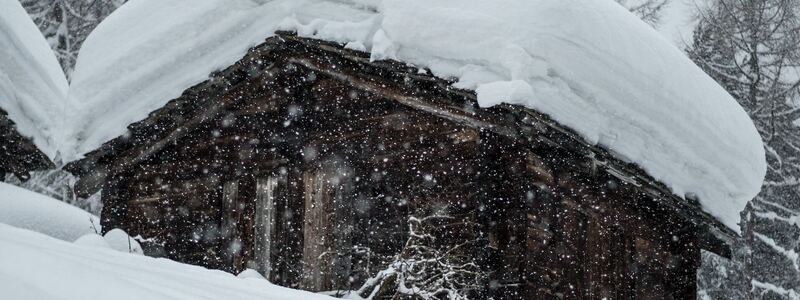
Fixing Step Flashing
Step flashing is a critical component in roof construction, especially where walls intersect with the roof. It helps in draining water downhill over the shingles, preventing leaks. However, when damaged, water can run underneath it and into your house, leading to significant problems. In our Winter Roof Repair Tips, we’ll guide you through the process of identifying and fixing step flashing to ensure a watertight roof.
Understanding Step Flashing:
- Step flashing consists of metal pieces bent at a 90-degree angle, placed between each course of shingles and the adjoining wall.
- It acts as a barrier, directing water away from the wall and onto the roof.
Identifying Damaged Step Flashing:
- Look for water stains or leaks inside the house near walls that intersect with the roof.
- Inspect the step flashing from the outside for rust, detachment, or other visible damage.
Repairing or Replacing Step Flashing:
- If the flashing is slightly damaged, it may be repaired with a roofing sealant.
- If the flashing is extensively damaged, it must be replaced.
- Carefully remove the damaged flashing and shingles, and replace them with new materials, ensuring proper overlap and sealing.
- Consider hiring a professional if the task seems complex, as improper installation can lead to further issues.
Safety Considerations:
- Use proper safety equipment, such as a roof harness, especially during winter when the roof may be slippery.
- Work with a partner or consider professional assistance if you’re unsure about the process.
Step flashing is an essential but often overlooked aspect of roof maintenance. Proper care and timely repair or replacement can prevent costly water damage inside your home. B&M Roofing is here to assist with all your step flashing needs, providing expert guidance and professional services to ensure your roof remains secure throughout the winter and beyond.
Choosing an Expert Team at Roofing
B&M Roofing has extensive experience in residential and commercial roofing, with a Colorado company providing quality service throughout the Centennial State since 1947.
The premier Colorado commercial roofing contractor uses only the highest quality roofing shingle suppliers: GAF and Owens Corning. We offer a wide range of colors and styles to choose from, ensuring that we can match the right roof shingle color to any home’s style.
We work with brands like GAF and Owens Corning to offer you a variety of roofing materials and colors to choose from and allow you to find the perfect color for your home. B&M is always available to help give your home’s roof the beauty it deserves.
How to Prepare Your Roof for Winter
As winter approaches, it is crucial to ensure your roof is adequately prepared to withstand harsh weather conditions. Properly winterizing your roof protects your home and helps maintain its structural integrity.
In this article, we will discuss key points on how to prepare your roof for winter, including tips for winterizing, protecting your roof from snow, and the best temperature for roof repairs. Considering these guidelines will help you ensure a well-maintained and durable roof throughout the winter months.
Preparing Your Roof in The Fall
Don’t wait for freezing weather. Take action when the fall arrives. Add the following to the checklist and contact a professional team to assist you with winterizing your roof:
- Inspect the roof for damage
- Clear debris and clean gutters
- Check insulation and ventilation
- Seal air leaks
- Schedule a repair or replacement if needed
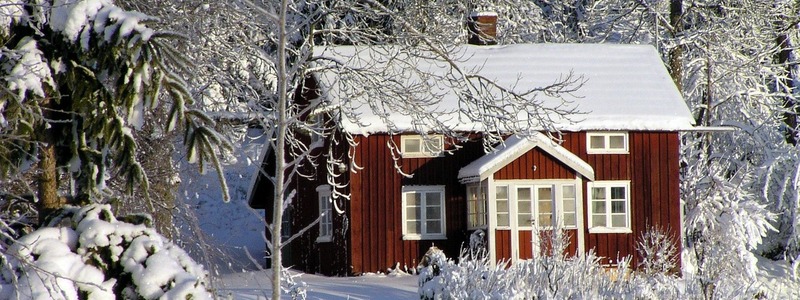
Conduct a Roof Inspection
Before winter arrives, perform at least a thorough inspection of your roof from the ground to identify any existing or potential issues. Look for obvious signs of damage, such as missing or damaged shingles, cracks, or loose flashing. Inspect the condition of your roof’s surface and pay attention to any areas of concern.
Identifying and addressing problems early on can prevent further damage during winter storms.
If you are unsure about conducting the inspection yourself, get in touch with a professional roofing contractor like B&M Roofing that can provide expert guidance and ensure a comprehensive evaluation. While inspecting your roof from the ground can provide a general overview, it is advisable to hire a professional for a more comprehensive assessment.
We have the expertise to identify potential issues that may go unnoticed by the untrained eye. By addressing these issues promptly, you can prevent further damage during winter storms and ensure the longevity of your roof.
Trim the Trees
If you have large trees around your house, plan to trim any branches that hang over your roof. During the winter, snow can accumulate on those branches, potentially causing them to break and crash onto your roof. Consider hiring a landscaping company to take care of any large branches you cannot safely reach. Trimming the trees will reduce the risk of damage and ensure the safety of your roof during winter storms
Clean and Clear Your Roof
Clearing debris from your roof is essential to prevent clogged gutters and potential water damage. If you can do it safely, remove leaves, twigs, and other debris that may have accumulated on your roof. Clean gutters and downspouts to ensure proper water drainage. Clogged gutters can lead to ice dams, which occur when melted snow freezes and forms a barrier, preventing water from flowing off the roof. Ice dams can cause water to back up under the shingles and potentially seep into your home, resulting in leaks and water damage.
Regular maintenance and cleaning will help prevent these issues and keep your roof functioning optimally.
Insulate and Ventilate Your Attic
Proper insulation and ventilation in your attic play a significant role in maintaining a warm and energy-efficient home during winter. Insufficient insulation can lead to heat loss, which can contribute to the formation of ice dams on the roof.
Check the insulation levels in your attic and consider adding more if necessary. Adequate insulation helps retain heat within your home, reducing the strain on your heating system and minimizing the risk of ice dams.
Furthermore, ensure that your attic is adequately ventilated to regulate temperature and humidity levels. Proper ventilation helps prevent excess moisture buildup, which can lead to mold growth and potential roof damage.
Seal Air Leaks
Air leaks in your home can contribute to heat loss and increase your energy bills. Inspect your roof and attic for gaps, cracks, or openings where warm air can escape.
Common areas for air leaks include around chimneys, vents, and attic hatches. Seal these areas with weatherstripping, caulk, or spray foam insulation to improve energy efficiency and reduce the chances of ice dam formation on your roof.
By sealing air leaks, you create a more airtight and well-insulated environment within your home, helping keep it warm and comfortable during winter.
Consider Roof Repair or Replacement
If your roof has significant damage or is nearing the end of its lifespan, it may be wise to consider repairs or replacement before winter arrives. Cold weather can make roofing tasks more challenging, and some roofing materials have temperature limitations for installation. If there are visible signs of damage, such as missing or damaged shingles, leaks, or sagging areas, consult with a professional roofing contractor to determine the best course of action.
At B&M Roofing, we can assess the condition of your roof and provide recommendations for repairs or replacement based on your specific situation.
How to Protect Your Roof from Snow
Heavy snowfall can stress your roof significantly, potentially leading to structural damage. To protect your roof from the weight of accumulated snow, consider installing snow guards. Snow guards are devices that are strategically placed on your roof to prevent large amounts of snow from sliding off all at once. By holding the snow in place, they reduce the risk of injury from falling snow and minimize the strain on your roof.
Snow guards also allow the snow to melt and drain more gradually, preventing the formation of ice dams.
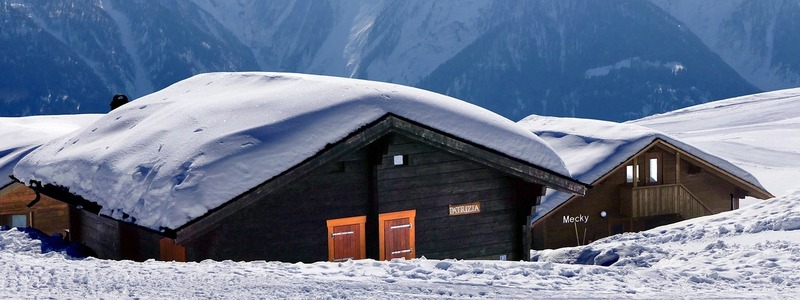
Ideal Temperature for Roof Repairs or Replacement
Roofing materials have specific temperature requirements for installation. Cold temperatures can make shingles and other materials brittle, making them more prone to damage during installation. It is generally recommended to avoid roofing tasks when the temperature falls below freezing (32 degrees).
Professionals have the expertise and knowledge to determine the best temperature and weather conditions for successful roof repairs or replacement. Do not, however, wait for everything to freeze before you call.
Why Not Do It Myself?
There are several reasons not to attempt DIY roof inspections and repairs. DIY inspections and repairs are very unlikely to save you money. They will surely leave issues unaddressed, your roof vulnerable to the elements and may shorten your roof’s lifespan, resulting in an urgent and premature need for roof replacement.
Risk
Walking around on your roof can be extremely dangerous, even for experienced individuals. Professional roofing contractors undergo countless hours of safety training, use special safety equipment to minimize risks, and still, accidents happen. No amount of money saved is worth risking your life.
Don’t hesitate to reach out to our expert team; we have the training and experience to inspect and repair your roof correctly. We know how to spot damage and how to make appropriate repairs to save you from urgently having to pay for things that could be avoided.
Material Warranty
Moreover, manufacturers of roofing materials require a licensed roofing contractor to install their materials for said material to qualify for their warranty. On the off chance you were to tackle your DIY roof repair successfully, you’ll have missed out on these warranties. If and when your repairs go bad, you’ll be stuck paying for more materials or, worse, for a completely new roof.
DIY roof repair isn’t worth the accompanying headache. At B&M Roofing, you get a licensed roofing contractor to perform biannual roof inspections safely.
Allow trained eyes to spot unseen wear and tear. Rest peacefully, knowing that your roof is in good shape as it endures season after season. The peace of mind from a qualified licensed contractor’s genuine interest in your well-being is abundant.
What Roof can Withstand Extreme Weather?
Some roofs fit into snowy conditions in Colorado more than others.
- Metal roofs can handle heavy snow and allow it to slide off easily.
- Cement roofs, although less common due to their cost, offer great protection against snow. They are durable and can resist moisture.
- Slate roofs are both beautiful and strong, capable of withstanding snow and ice. However, slate is expensive.
Overall, these roofs provide durability and resilience against the snowy weather conditions in Colorado.
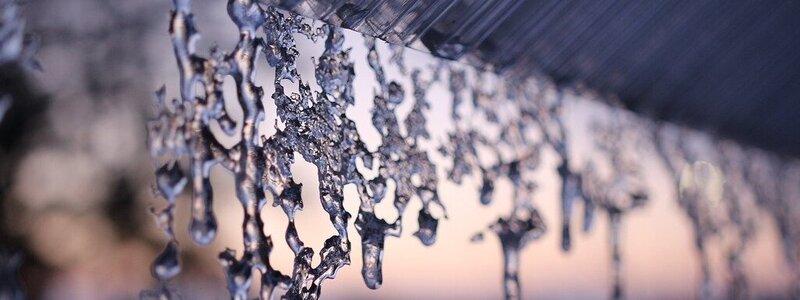
Inspect and Prepare
Preparing your roof for winter is essential for its longevity and for protecting your home from the elements. Adhering to temperature guidelines while planning roofing tasks ensures optimal results. With proper preparation, your roof will withstand the winter season, providing you with peace of mind and a comfortable living environment.
Our professional team has the experience to inspect, repair and replace your roof. Contact us to discuss how we can help you, schedule a convenient time to visit your house, and allow our team to give you customized solutions.
B&M Roofing Colorado’s Most Trusted
If you think it’s time to replace your roof, regardless of the size of your home, this is an important decision that you should not rush into. You need to make sure you choose the right roofing installation company, that the roof is installed correctly and that the weather cooperates during the replacement process.
For more information about roof maintenance, repair, or replacement. Call us at 303-816-0068 or fill out a contact form.
Roof Replacement Process
A roof replacement is a significant home improvement project that requires careful planning and execution. Whether due to age, damage, or a desire to enhance your home’s esthetic appeal and functionality, understanding the roof replacement process is crucial.
This article will provide you with valuable insights into the steps involved in roof replacement, and answer common questions about the process, materials, insurance, and more.

The Roof Replacement Process
The roof replacement process typically follows a series of steps to ensure a successful and long-lasting outcome. While each roofing company may slightly vary its processes, the core steps remain consistent.
Sometimes, if the existing roof is in relatively good condition and local building codes permit, it may be possible to install new roofing materials directly over the existing roof. This approach can save time and money, but it’s essential to consider factors like weight restrictions and the condition of the underlying structure.
Here is an overview of the most common roof replacement process:
Inspection and Assessment
A professional roofer assesses the condition of the existing roof, identifying any signs of damage or underlying issues. They examine the roof’s structure, decking, insulation, and ventilation systems to ensure optimal condition.
Obtaining Permits
Depending on your local regulations, permits may be required before commencing a roof replacement project. Your roofing contractor will assist in obtaining the necessary permits to ensure compliance with building codes.
Material Selection
Choose the roofing materials that best suit your needs, preferences, and budget.
Removal of Existing Roof
The old roofing materials are carefully removed, ensuring the underlying structure remains intact. The removal process may involve stripping off shingles, underlayment, flashing, and other components.
Repair and Preparation
Damaged or rotted sections of the roof decking are replaced. The roof surface is inspected for any necessary repairs or reinforcements before the installation of new materials.
Installation
The new roofing materials are installed according to the manufacturer’s guidelines and industry best practices. This includes laying underlayment, applying shingles or other chosen materials, and installing flashing and ventilation systems.
Cleanup and Inspection
The job site is thoroughly cleaned of debris, ensuring the surrounding areas are safe and tidy. A final inspection is conducted to verify the quality of the installation and address any remaining concerns.
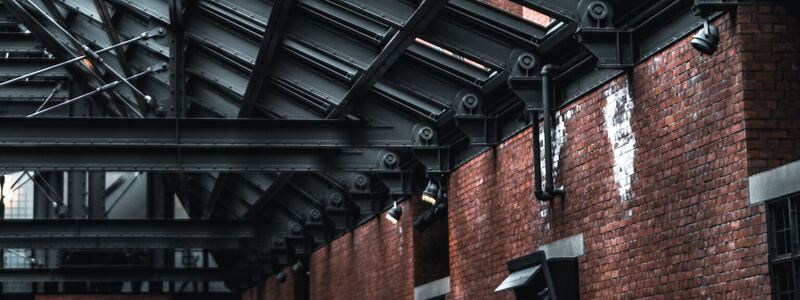
Common Questions About Roof Replacement
- Should I stay home during the roof replacement?
While you don’t need to stay home during the entire roof replacement process, it is advisable to be present during critical stages such as the initial inspection, material selection, and final inspection. This allows you to stay informed, address any concerns, and ensure that the project progresses smoothly.
- Do roofers need to come inside the house?
Roofers generally do not need to enter the interior of your home during a roof replacement unless some specific requirements or issues need to be addressed. Most of the work is conducted externally, focusing on the roof structure itself.
- How long does a roof replacement take?
The duration of a roof replacement project varies depending on several factors, including the roof size, weather conditions, and the efficiency of the roofing crew.
A roof replacement can take a few days to a couple of weeks. Your roofing contractor will provide a more accurate timeline based on your project.
Contact our experienced team at B&M Roofing today for a free estimate!
Types of Roof Pitches and Examples
Roof pitch refers to the slope or angle of a roof. Different roof pitches serve specific purposes and are used in various building types. Here are some common types of roof pitches:
Low Slope Roofs
Roof Pitch 2:12 to 4:12
Examples include flat roofs, low-slope metal roofs, and modern architectural designs.
Conventional Slope Roofs
Roof Pitch 4:12 to 9:12
Examples include traditional gable roofs, hip roofs, and shed roofs commonly found in residential homes.
Steeper Slope Roofs
Roof Pitch: 9:12 to 21:12
Examples include Victorian-style roofs, Dutch gable roofs, and French country roofs.
High Slope Roofs
Roof Pitch 21:12 and above
Examples are Gothic-style roofs, Tudor-style roofs, and some barn roofs.
You can use a simple method to determine the pitch or slope of your roof. Find a point on your roof and measure how steep it is. You can figure out the pitch by looking at how much the roof goes up compared to how far it extends horizontally. Another option is to consult a professional roofer who has the tools and knowledge to assess the pitch of your roof.
Commonly Used Roofing Materials
Asphalt Shingles: Most popular roofing material due to affordability, durability, and ease of installation. Available in various styles and colors, providing versatility in design.
Metal Roofing: Offers exceptional durability, longevity, and energy efficiency. Common materials include steel, aluminum, and copper.
Tile Roofing: Provides a classic and elegant look, often seen in Mediterranean or Spanish-style architecture. Materials include clay and concrete tiles, offering durability and resistance to fire and rot.
Slate Roofing: Known for its natural beauty, durability, and longevity. Requires professional installation due to its weight and specialized handling.
Wood Shakes and Shingles: Offers a rustic and charming appearance, commonly used in traditional and historic homes. Requires regular maintenance and may have restrictions in fire-prone areas.
Synthetic Roofing Materials: Engineered to mimic the appearance of natural materials like slate or wood shakes. These are cost-effective alternatives with improved durability and reduced maintenance.

Roofing in Colorado: Aspects to Consider
Roofing in Colorado has some specific characteristics and considerations compared to other states due to the state’s unique climate, geography, and building codes.
Weather Conditions
Colorado experiences a wide range of weather conditions throughout the year, including heavy snowfall, intense sunlight, high winds, and occasional hailstorms. These weather elements can impact the longevity and durability of the roofing materials used.
Due to the high elevation and exposure to sunlight, roofs in Colorado are prone to faster deterioration from UV rays. Choosing roofing materials that can withstand UV radiation and extreme temperature fluctuations is crucial.
Snow Loads and Ice Dams
Colorado’s mountainous regions receive significant snowfall during winter. Roofs need to be designed and constructed to withstand the weight of heavy snow loads.
Proper insulation and ventilation are essential to prevent the formation of ice dams, which can cause water infiltration and damage to the roof structure.
Wind Resistance
The state experiences strong winds, particularly in open plains and mountain areas. Roofs must be designed and installed to withstand these wind forces.
Selecting appropriate roofing materials, fastening methods, and adherence to local building codes regarding wind resistance ensures the roof’s stability.
Impact Resistance
Impact-resistant roofing materials, such as impact-rated shingles or metal roofing, can provide increased protection against hail damage.
Building Codes and Regulations
There are specific building codes and regulations related to roofing to ensure safety and structural integrity. These codes may include requirements for wind resistance, snow load calculations, ventilation, insulation, and fire ratings.
It’s important to work with roofing professionals knowledgeable about Colorado’s building codes and ensure compliance with these regulations during roof installation or replacement.
Energy Efficiency
Colorado residents often prioritize energy efficiency due to the state’s temperature variations and the desire to reduce utility costs. Roofing materials with high thermal insulation properties, such as cool roofs or energy-efficient shingles, can help maintain a comfortable indoor temperature and reduce energy consumption.
When considering roofing in Colorado, it’s crucial to consult with experienced roofing contractors familiar with the specific challenges posed by the state’s climate and building codes.
Roof Replacement by Professionals | B&M Roofing
B&M Roofing has extensive experience in residential and commercial roofing, with a Colorado company providing quality service throughout the Centennial State since 1947.
The premier Colorado commercial roofing contractor uses only the highest quality roofing shingle suppliers: GAF and Owens Corning. We offer a wide range of colors and styles to choose from, ensuring that we can match the right roof shingle color to any home’s style.
We work with brands like GAF and Owens Corning to offer you a variety of roofing materials and colors to choose from and allow you to find the perfect color for your home. B&M is always available to help give your home’s roof the beauty it deserves.
How to Prepare for Hailstorms
Hailstorms can be incredibly destructive, causing significant damage to homes and properties. For residents of Colorado, where hailstorms are a common occurrence, being prepared for these natural phenomena is essential. As a roofing company based in Colorado, B&M Roofing understands the importance of proactive measures to safeguard homes from hail damage.
In this article, we will provide valuable insights and practical tips on how to prepare for hailstorms. We will explore the necessary steps homeowners can take to minimize potential harm to their roofs, protect their belongings, and ensure the safety of their loved ones.
From inspecting the roof for vulnerabilities and reinforcing it with hail-resistant materials to installing protective coverings and implementing preventive maintenance strategies, we will delve into various approaches that can significantly reduce the impact of hailstorms on residential properties.
By adopting the proactive measures outlined in this article, homeowners can enhance their preparedness, safeguard their homes, and potentially avoid costly repairs or replacements in the aftermath of hailstorms. Let’s dive in and learn how to prepare for hailstorms effectively.
What is Hail?
If you live in Colorado, you know the damage hail can cause, but did you know that it is formed when water vapor in updrafts reaches a freezing point? Ice is formed and is suspended in the air by updrafts and falls down to be coated by water again.
This process can occur over and over again, adding several layers to the hailstone, which is how golf ball-sized hail can occur. While the average hailstorm only lasts five minutes, the damage can be extremely detrimental.
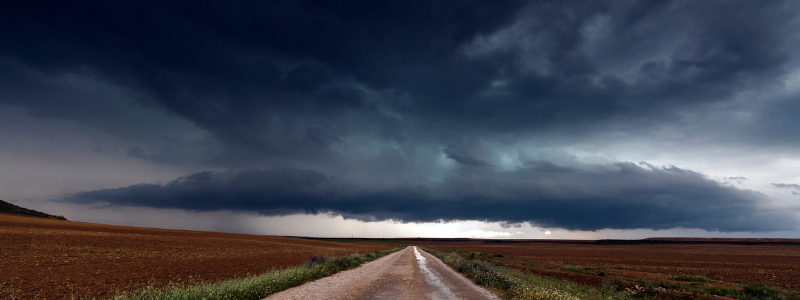
Signs of a Potential Hail Storm
There are a few signs that hail may fall, so if you notice these changes in the weather, start preparing. The sooner you prepare, the more you’ll be able to prevent hail damage.
- A solid (not gradient) wall of dark blue/grey clouds, in contrast with little-to-no clouds – These clouds bring a lot of moisture, along with a cold front. The two together mean a mixture of cold and rain.
- A sudden wave of wind gusts that are higher up in the air – A side draft (between updraft and downdraft) or fluctuating draft is a true sign that a violent thunderstorm is approaching.
- Thunder/lightning – This usually means rain is coming, and given the frequency, it could bring a quick hail storm, too. Not all thunderstorms bring hail, but all hail usually comes with a thunderstorm. So it’s good practice to be prepared any time you hear thunder.
- A quick drop in temperature – When it gets colder, it’s even colder in the atmosphere. This contributes to the creation of hail.
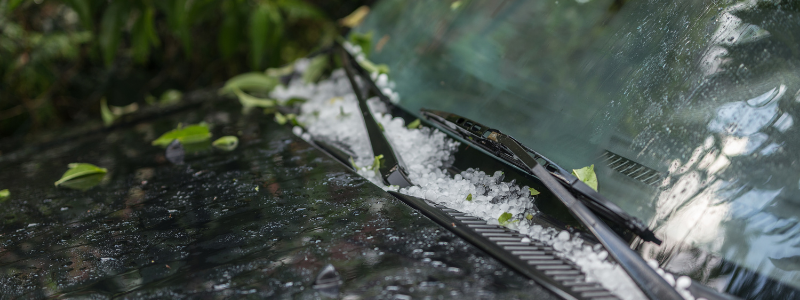
How to Prepare for Hailstorms
When it comes to hailstorms, preparation is key to minimizing potential damage to your home. By taking proactive steps and implementing preventive measures, you can protect your property and ensure the safety of your loved ones. Here are some essential tips on how to prepare for hailstorms:
- Inspect Your Roof Regularly
Perform a thorough inspection of your roof to identify any existing vulnerabilities. Look for signs of wear and tear, loose or damaged shingles, and weak spots that may be susceptible to hail damage. If you notice any issues, contact a professional roofing company like B&M Roofing to address the problems promptly.
- Reinforce Your Roof
- Install Protective Coverings
In areas prone to frequent hailstorms, installing protective coverings like hail guards or screens can provide an added defense for your windows, skylights, and other vulnerable areas. These coverings can help prevent shattered glass and minimize potential damage caused by hailstones.
- Trim Overhanging Trees
Trim any overhanging tree branches near your home, especially those that could potentially break or fall during a hailstorm. Falling branches can cause severe damage to your roof, siding, or windows when combined with hail impact.
- Secure Outdoor Items
Secure or move any outdoor furniture, equipment, or valuables that could be damaged by hail. Strong winds accompanying hailstorms can turn these items into projectiles, posing a significant risk to your property and others nearby.
- Have Emergency Supplies Ready
Prepare an emergency kit that includes essentials such as flashlights, batteries, first aid supplies, and non-perishable food items. Additionally, ensure you have a reliable method of communication, such as a charged mobile phone or a battery-operated radio, to stay informed about weather updates and emergency alerts.
By following these proactive measures and staying prepared, you can significantly reduce the impact of hailstorms on your home. Remember, the safety of your family should always be the top priority. If severe weather conditions are expected, consider seeking shelter in a designated safe area until the storm passes.
How to Prevent Hail Damage to Your Car
Cars can take quite the abuse from Colorado’s harsh weather, but there are a few ways you can protect your car from hail damage.
- Seek cover in covered parking/areas – If you’re on the road frequently (i.e. commuting) know where the closest parking garages are so you can safely ride out the storm. If you can’t reach a garage before the storm hits, pull under an overpass, gas station canopy, or similar spot that can help protect you and your car from hail. Even the overhang from trees may be enough to slow the hail down enough from damaging your car.
- Face the hail head-on – If you can’t find cover, drive into the hail so that the hail hits your windshield rather than your side and rear windows. Your windshield is much stronger than the other windows.
- Park on the side of the building, opposite of the wind direction – If overhead cover isn’t available, try and park on the opposite side of the building from the direction the wind is blowing. The hail may not reach your car as much.
- Use blankets to cover the car – If you can’t get your car to shelter, raid your linen closet and cover the car with any thick blankets, comforters, or even large towels. The more layers, the better!
- Use cardboard to cover the car – Cardboard may also serve as a good source of “padding” and protection against hail. Place it under your windshield wipers to keep them from moving around and the cardboard layers can usually take the brunt of the hail impact.
- Use floor mats to cover the car – If nothing else is available, your car’s floor mats are a great option to use as protection from hail. Place the floor mats carpet-side-up, under your windshield wipers. For side windows, you may have to wedge them up into the rubber window lining.
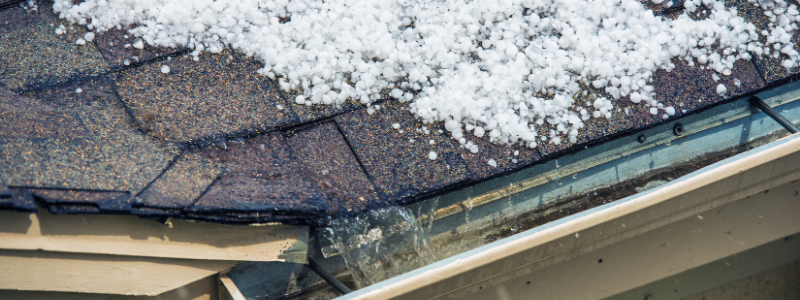
How to Prevent Hail Damage to Your Home
Some hail damage is inevitable, but there are a few good tips that will help limit damage, if any, to your home.
- Close curtains – Make sure to close any curtains or blinds, so that if your windows break, no glass or debris gets blown into the home.
- Trim trees/branches – While the weather is nice, be sure to maintain your trees and shrubbery in your yard. Especially for those taller trees that are closer to your roof, remove any weak branches.
- Protect outdoor furniture – Bring all patio and lawn furniture inside or under a covered area.
- Close umbrellas/canopies/tarps – Hail will rip these fabrics to shreds, so keep them closed when a storm approaches.
- Consider window coverings – Things like hinged shutters or metal awnings may be a good idea, as they’re easier to replace or repair than broken windows.
As we mentioned, some hail damage to your home is inevitable, like damage to your roof. Your home’s roof may take the brunt of the hail impact, but the cost to fix/repair/repair roof shingles is much less compared to other things in and around your home.
How to B&M Roofing Can Help With Hail Damage
B&M Roofing isn’t just another “storm chaser” company. We’re local, we’re experienced, and we’re honest. We’ve seen a hail storm or two and know just exactly what types of damage to expect and look for. If we can save you costs, we will.
- Roof inspections – Call B&M Roofing to inspect your roof shingles for wind or hail damage after a hailstorm.
- Durable, storm-grade materials – The roofing materials offered by B&M Roofing are the most impact-resistant roofing materials, proven to be able to withstand Colorado weather. We only work with the most trusted roofing material companies.
- Proactive maintenance – Early in the spring months, like March or April, we can take some preventative measures with preparing your roof for the hail season.
After a serious hailstorm, be sure to call your insurance company to schedule a damage assessment and then give B&M Roofing a call to make any necessary repairs. At B&M Roofing, we service everything from small residential roofs to large, complicated commercial properties throughout Colorado and surrounding areas.
Hail Season in Colorado
Hail season in Colorado… Just hearing those words is enough to make any Coloradan tremble. We all know that our beloved state of Colorado is no stranger to extreme weather, and hailstorms are one of the many challenges we face here in the beautiful Front Range area. If you’ve ever experienced the fury of a hailstorm, you know the damage it can cause, especially to our homes and roofs. But fear not! B&M Roofing, your local roofing experts, are here to help you weather the storm.
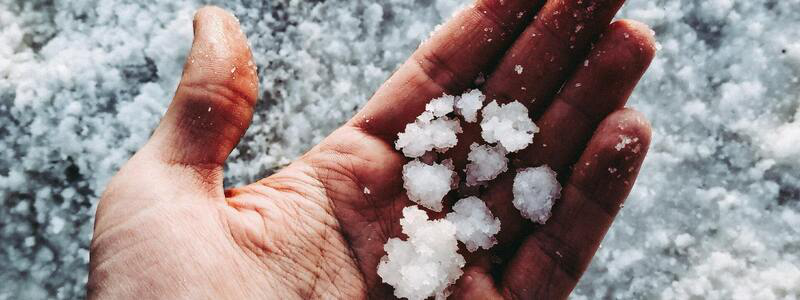
How Common is Hail in Colorado?
Colorado is located right in the heart of”Hail Alley,” a region stretching from Wyoming to Texas that sees some of the most intense hailstorms in North America.
So, it’s safe to say that hail is no stranger to our state.
But just how often do we find ourselves dodging icy pellets from the sky?
How often are hail storms in Colorado?
Hailstorms can occur at any time of the year in Colorado, but they are most common during the spring and summer months. In fact, Colorado averages about three to four major hailstorms each year. That’s right, Mother Nature can really throw one hail of a party!
In just a short length of time, maybe even just one spring/summer, you’ve likely experienced at least a few hailstorms. It’s practically a rite of passage for all Coloradans. But hey, look on the bright side – at least we have some interesting stories to tell our friends from out of state! And the pictures to prove them!
When is Hail Season in Colorado?
Hail season in Colorado typically runs from late spring to late summer (with some storms even in early fall), with the highest frequency of hailstorms occurring in May, June, July, and August. Sometimes as early as April.
It’s during this time that our unpredictable weather patterns can turn a sunny day into a hailstorm in the blink of an eye.
So, when you hear those ominous rumblings and see dark clouds gathering, it’s a good idea to keep an eye on the sky and be prepared for the possibility of hail.
What Month Has The Most Hail in Colorado?
Ah, the million-dollar question: what month brings us the most hail in Colorado?
Well, statistically speaking, July takes the crown.
It seems that summer is the season when hailstones like to make their grand entrance, causing havoc and making our roofs feel like they’re under attack.
So, if you’re planning any outdoor activities during this month, make sure you have a contingency plan in case a hailstorm decides to crash the party.
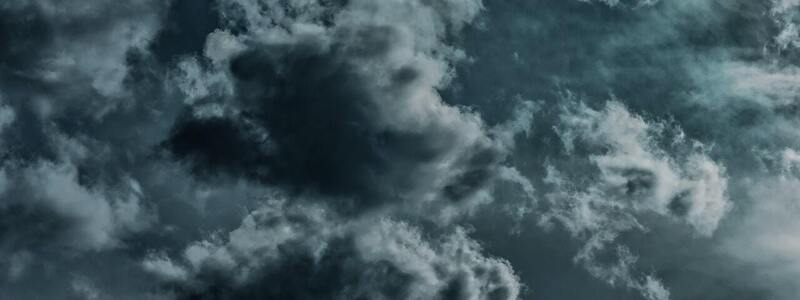
What Part of Colorado Gets the Most Hail?
Now, you might be wondering if hailstorms play favorites when it comes to the different regions of Colorado. And the answer is, yes, they do!
While hail can strike anywhere in our beautiful state, certain areas tend to see more hail than others.
So, where should you be on high alert for hail?
The Front Range
Well, lucky for us, we’re right here in the Front Range area, and boy, do we get our fair share of hailstorms. From Fort Collins to Denver and all the cities in between, we’re in the prime zone for hail. It’s like living in the middle of a giant target that Mother Nature likes to aim for. But fear not, because B&M Roofing, based right here in Frederick, is at your service to protect your roofs from hail damage.
Eastern Plains
If you venture out east towards the Plains, you’ll find another hail hotspot.
The Eastern Plains of Colorado experience frequent hailstorms, thanks to the unique weather patterns that sweep across the region. So, if you’re a proud resident of the Eastern Plains, you know the drill – keep an eye on the sky, seek shelter when necessary, and make sure your roof is prepared to withstand the hail onslaught. We do also service this region, so don’t hesitate to call us, as we’re not far away.
Mountainous Regions
Now, you might think that the mountainous regions would be safe from hail, but think again! Even our majestic mountains are not immune to hailstorms. In fact, the high elevation and unique atmospheric conditions can create perfect conditions for hail formation. So, whether you’re living in the foothills or high up in the Rockies, it’s essential to have a sturdy roof that can withstand the impact of hailstones. If you find yourself “up the hill” from us, unfortunately, we do not service your area. We are happy to give recommendations, though, if you contact us.
Protecting Your RoofDuring Hail Season
Now that we’ve established that hail season in Colorado is a force to be reckoned with, let’s talk about how you can protect your roof from hail damage. Here are a few tips to keep in mind:
- Inspect Your Roof Regularly: Before hail season hits, it’s a good idea to inspect your roof for any signs of damage or vulnerability. Look for loose or damaged shingles, cracks, or weak spots that could be susceptible to hail impact. If you’re not comfortable doing the inspection yourself, you can always rely on the experts at B&M Roofing to assess the condition of your roof.
- Consider Impact-Resistant Roofing Materials: When it comes to hail, not all roofing materials are created equal. Consider investing in impact-resistant roofing materials that are designed to withstand the force of hailstones. Options such as asphalt shingles with a higher impact resistance rating or metal roofing can provide an added layer of protection for your home.
- Maintain Proper Roof Ventilation: Adequate roof ventilation is crucial for preventing heat and moisture buildup in your attic, which can weaken the structure of your roof. Make sure your attic is properly ventilated to reduce the risk of hail damage and other roofing issues.
- Trim Trees and Overhanging Branches: During a hailstorm, overhanging branches can pose a significant risk to your roof. Trim any branches that are close to your roof or could potentially fall onto it during a storm. This will help minimize the chances of damage from falling branches and hail impact.
- Consider Impact-Resistant Skylights: Skylights can add beauty and natural light to your home, but they can also be vulnerable to hail damage. If you have skylights, consider upgrading to impact-resistant options that are designed to withstand the impact of hailstones.
- Insurance Coverage: Review your homeowner’s insurance policy to understand what coverage you have for hail damage. Ensure that your policy adequately protects your home and belongings in the event of a hailstorm. If you have any questions or concerns about your coverage, don’t hesitate to reach out to your insurance provider.
Trust B&M Roofing for Your Hail-Related Roofing Needs
When it comes to hail season in Colorado, having a reliable and local roofing partner can make all the difference. That’s where B&M Roofing comes in. As your trusted roofing experts in the Front Range area, we understand the unique challenges posed by hailstorms, and we’re here to help you navigate through them.
Here’s why choosing B&M Roofing for your hail-related roofing needs is a smart move:
- Local Expertise: We are a local company based in Frederick, Colorado. Being in the heart of the Front Range area allows us to respond quickly and effectively to any roofing emergencies or hail-related issues. We know the ins and outs of Colorado weather and the specific needs of roofs in our region.
- Timely Response: When hail strikes, time is of the essence. With B&M Roofing, you can count on us to respond promptly to your roofing needs. We understand the urgency and will work diligently to assess and repair any hail damage to your roof.
- Quality Workmanship: We take pride in our work and strive for excellence in every project we undertake. Our experienced roofing professionals are skilled in identifying and repairing hail damage, ensuring that your roof is restored to its optimal condition.
- Customer Satisfaction: Our customers are at the heart of everything we do. We believe in building strong relationships based on trust, transparency, and exceptional customer service. We’ll guide you through the entire process, from the initial assessment to the final repairs, ensuring your satisfaction every step of the way.
Remember, hail season in Colorado may be unpredictable, but you can take proactive steps to protect your roof and minimize the impact of hailstorms. And when you need a reliable roofing partner, B&M Roofing is just a call away.
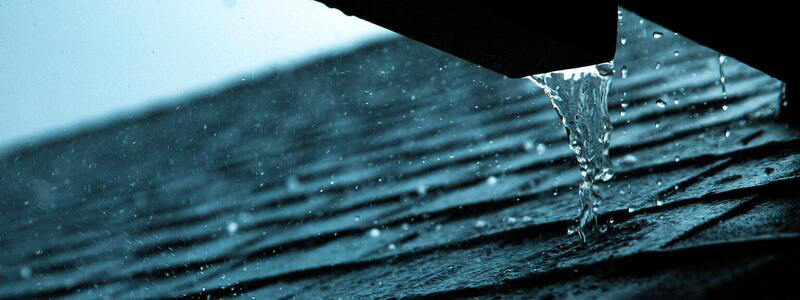
Don’t let hailstorms rain on your parade. Reach out to B&M Roofing today and let us help you weather the storm with confidence!
Call us today at 303.938.9642 to schedule a visit from our emergency repair team or visit our leak repair request page to submit your information and have one of our team members contact you.
Our 24/7 support line is here to help immediately with emergency roof repair. Calling sooner means less of a wait and more opportunities to repair before extensive damage is done. We offer work throughout Colorado, including:
- Denver
- Colorado Springs
- Fort Collins
- Boulder
- Greeley
- Rocky Mountain areas
- Surrounding states including Wyoming, Utah, Kansas, Nebraska
Best Roof For Hail
Hailstorms can cause significant damage to homes and property. Hailstones can range from golf ball size to baseball-sized. The force of these stones can break windows, shatter glass doors, and even dent vehicles.
There are some areas such as Colorado that are prone to hail during April and into July. Therefore, having the best roof for hail will provide protection and help anticipates the damage. There are several types of roofs that can withstand strong winds and heavy rain.
In this article, we will be discussing what are the best roofs and materials that will endure hail.
Damage Caused by Hail on The Roof
In Colorado, you will be familiar with the damage that hail can cause to your roofs. Even though a hailstorm may only last a couple of minutes, it can cause disastrous damage in that short amount of time to your roof.
Hail can do multiple things to your roof, it can not only damage your roof but also damage other elements of the roof. Such as the chimney, gutters, vents, and skylights. Alongside that, hail can crack the shingles, (except the hail resistant shingles) and weaken the seals on your roof, just to name a few.
All of these things then lead to leaks starting to form in our roof, which can lead to further damage in your home. As a result, it is important to stay on top of any damage that is caused to your roof. Thus, if you notice any damage to your roof or suspect any damage, then you call a professional to inspect your roof.
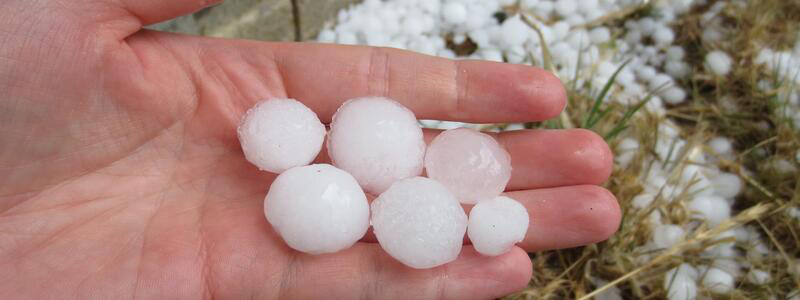
What Is The Best Roof for Hail Storms?
There are many kinds of best roofs for hail storms that can be used for protecting your home. Some of them include:
Metal Roofs
Metal roofs have been around for years, and they still remain one of the most popular best roof for hail. They are made out of metal sheets that are attached together with screws, nails, etc. Metal roofs are very durable and long-lasting, which makes them an excellent choice for protecting your home from severe weather conditions. However, there are some cons associated with using metal roofs. One of the main con there is the chance that if the hail is big enough, it can dent the roof, especially if you have a flat roof.
Thicker metal panels are much more durable as they can deflect the hail. Yet over time, the impact of multiple hail storms will begin to show.
Impact-Resistant Shingles
Asphalt shingles are a popular choice for residential roofs, and luckily, there are impact-resistant options available. These shingles are specially designed to withstand the force of hailstones. They are constructed with reinforced fiberglass matting and have a higher impact resistance rating than standard shingles. Impact-resistant shingles can help minimize the risk of damage and prolong the lifespan of your roof.
Slate or Tile Roofs
Slate and tile roofs are renowned for their resilience and longevity. These materials have a natural resistance to hail damage due to their solid and robust composition. Slate and tile roofs can withstand the impact of hailstones without sustaining significant damage. While they may be a higher initial investment, they offer exceptional durability and an elegant appearance.
Rubber/EuroShield Roofs
Synthetic roofing materials, such as synthetic slate or rubberized shingles, are gaining popularity due to their hail-resistant properties. These materials are engineered to mimic the look and durability of natural materials while providing additional impact resistance. They can withstand hailstorms without cracking or breaking, offering excellent protection for your home.
These rubber roofs are very sturdy as they absorb all the impact caused by the hail. Thus, the hail easily bounces off the roof. Alongside that, rubber roofs are made from recycled tires and come in various styles and colors. Yet, they are an eco-friendly option that are also very low maintenance.
Tile Roofs
Tile roofs can be made from slate, clay, concrete, or ceramic and will last for many years. This type of roof is ideal for hailstones that are smaller than 2 inches. However, if the hail is any bigger, then the chances of the tiles breaking or chipping is increased, which may also not be covered by some insurance companies.
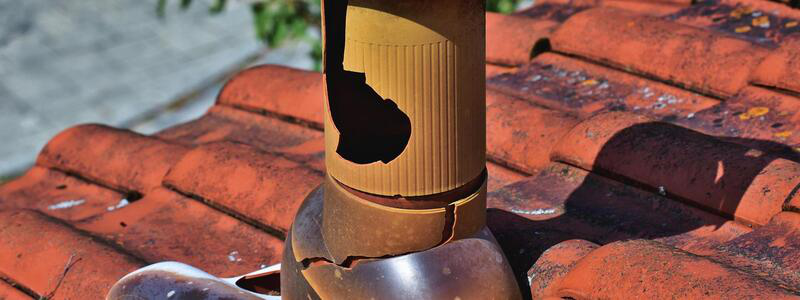
Class 4 Hail Resistant Metal Roof
A class 4 hail-resistant metal roof is the highest impact rated roof you can get your hands on. They can withstand hail that is around 2 inches big. Often these roofs are made from aluminum, copper, asphalt, plastic or resin shingles.
These roofs can also stand 110 miles per hour winds and are a great long term investment. If you want a roof that will give you long-term protection from hailstorms, then you may want to consider a class 4 roof. Especially, as their impact rating is so high, you will have to spend less money on this roof for maintenance or replacement costs.
F-Wave Roofs
An F-wave roof is another low-maintenance roof that is very durable and lightweight. They also have a class 4 hail rating and can withstand 130 miles per hour winds. When you purchase an F-wave roof there is the option to have roofs that look similar to slate, asphalt or cedar shakes.
An F-wave roof is one of the few roofs that have a hail warranty, which is very handy when it comes to living in Colorado.
What Materials Are Hail Proof?
Hailstorms can wreak havoc on our homes, causing extensive damage to roofs and leaving us with hefty repair bills. Therefore, it’s natural to wonder if there are any materials that are hail-proof. While no material can claim to be completely immune to hail damage, some options offer higher levels of resistance than others. Let’s explore a few materials known for their hail-resistant properties:
- Metal Roofing: Metal roofs, typically made of steel, aluminum, or copper, are highly regarded for their durability and resilience. Metal panels are inherently strong and can withstand the impact of hailstones. Additionally, their smooth and slippery surfaces allow hail to slide off more easily, reducing the risk of damage. Metal roofs are a popular choice in hail-prone areas due to their ability to deflect hailstones and minimize potential harm.
- Stone-Coated Steel: Stone-coated steel roofing combines the strength of metal with a protective layer of stone chips. This combination creates a highly durable and hail-resistant material. The stone coating adds an extra layer of protection against hail impact and helps to absorb and distribute the force. Stone-coated steel roofs are an excellent choice for areas susceptible to severe hailstorms.
- Synthetic Roofing Materials: Synthetic roofing materials, such as synthetic slate, rubberized shingles, or polymer-based tiles, offer a hail-resistant alternative to natural materials. These synthetic options are engineered to withstand the impact of hailstones without cracking or breaking. They are designed to be flexible and durable, providing a high level of resistance to hail damage. Synthetic roofing materials are a popular choice for homeowners seeking both durability and aesthetic appeal.
- Concrete and Clay Tiles: Concrete and clay tiles are known for their robustness and ability to withstand harsh weather conditions. These tiles are naturally resistant to hail impact due to their solid composition. The density and thickness of concrete and clay tiles provide excellent protection against hail damage. However, it’s worth noting that extremely large hailstones or severe hailstorms can still cause some level of damage to these materials.
While these materials offer a higher level of hail resistance compared to others, it’s important to remember that no roof is entirely hail-proof.
In severe hailstorms with unusually large hailstones, even the most resilient materials can sustain some damage. However, choosing hail-resistant materials can significantly reduce the risk and extent of damage to your roof.
When considering hail-resistant materials, it’s essential to consult with roofing professionals who have expertise in hail-prone regions. They can provide guidance on the best materials for your specific climate and help you make an informed decision based on your needs and budget.
Are Metal Roofs The Best for Hail Storms?
Yes, metal roofs are better for hail because they are very durable and strong. As we mentioned before, the only thing that could damage a metal roof is a large hail storm. Even then, the chances of damaging the roof are minimal.
Metal roofs are also very easy to install and maintain. You do not need to worry about any special tools or skills needed to install a metal roof. All you need to do is attach the metal sheets together with screws, nails etc. Once the roof is installed, you just need to make sure that you keep it clean and free of debris.
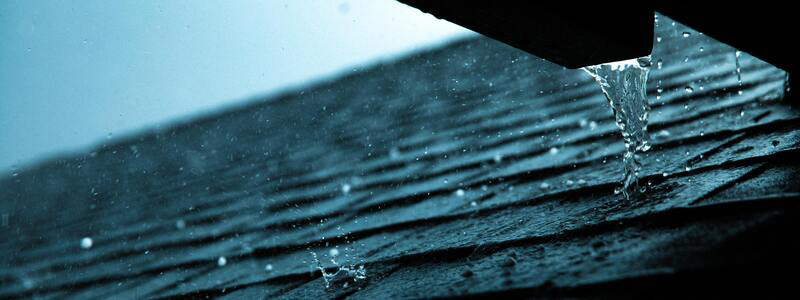
What Can I Do To Protect My Roof From Hail?
If you live in an area where hail storms are common, then you should take steps to protect your roof against the effects of hailstorms. The best way to do this is to choose a good roof system for your home. A roof that has been designed specifically for hail resistance will help to protect your home from hailstorms.
Alongside that, when the weather is nice, you should keep your trees and shrubs maintained. If you have tall trees, then you should remove any branches that are considered weak. Otherwise, when a hail storm occurs, these branches could fall down and damage your roof.
Your home also needs to be protected by hail alongside your roof. To protect the rest of your home, you should close any blinds or curtains so that if any windows break during the storm, no glass will be blown into your home. Also, hinge shutters are a great idea to have installed. This is because they are much easier to repair or replace than a broken window.
Finally, any outdoor furniture must be put under a covered area or brought inside to keep them safe. Also close all tarps, umbrellas or canopies in the garden. Otherwise, the hail storm will destroy the fabric. So it’s best to keep them closed.
Protect Your Roof with B&M Roofing Colorado
In Colorado, hail storms are very popular and can cause a lot of damage to your roof. Hence, having a metal or rubber roofs could help prevent your roof from being damaged due to hail.
At B&M Roofing, we inspect your roofs for hail damage, and offer you durable and hail resistant materials to be used on your roofs. We will also offer you preventive measures in the spring before the hail season.
Call us today at 303.938.9642 to schedule a visit from our emergency repair team or visit our leak repair request page to submit your information and have one of our team members contact you.
Our 24/7 support line is here to help immediately with emergency roof repair. Calling sooner means less of a wait and more opportunities to repair before extensive damage is done. We offer work throughout Colorado, including:
- Denver
- Colorado Springs
- Fort Collins
- Boulder
- Greeley
- Rocky Mountain areas
- Surrounding states including Wyoming, Utah, Kansas, Nebraska
Roofing Companies Denver
There are different roofing companies in Denver, Colorado, and B&M Roofing is one of the industry leaders. These roofing companies render different services, ranging from commercial to residential. So, irrespective of your roofing needs, a roofing company in Denver, Colorado, can cater to your needs.
But what exactly can you expect from these roofing companies in Denver? Is it important to hire one? And who are the top roofers in Denver? This article answers these questions and more.

What Do Roofing Companies Do in Colorado?
Before discussing what roofing companies do in Colorado, it is essential to explain the different types of roofers there are in Denver, Colorado.
- Commercial Roofers: Commercial roofing services focuses on installing or replacing flat roofs and other industrial applications. They focus primarily on commercial construction and sometimes carry out residential projects.
- Residential Roofers: As the name implies, residential roofing services focus on personal homes. Residential roofers work on shingle and metal roof installation, maintenance, repair, and replacement.
- Industrial Roofers: Industrial roofing services deal with maintaining and repairing industrial roofs. Industrial roofers focus on metal roofs and industrial applications.
- Roofing Contractors: This refers to roofers who work on commercial and residential buildings. If you need a general contractor, it is best to go with roofing contractors in Denver, as they have experience in both roofing types. Also, roofing contractors act as a one-stop shop for all your roofing needs.
Now, what do these roofing companies in Colorado do?
Roof Installation
Roof installation is quite common, and it involves putting a new roof on your house or business structure. Installing a new roof takes time and requires the expertise of seasoned roofers. So, carefully choose the roofing company to handle this project.
Roof Repair
Roof repair is another common service rendered by roofing companies in Denver. However, unlike roof installation, the focus here is on fixing any damaged part of your roof. For this to happen, the roofing contractor will assess the damage and tell you what repair the roof needs.
Roof Replacement
Replacement is different from repair. Here, you might have to haul an entire section rather than fix a damaged part of the roof. This makes roof replacement a job for the experts, so hire a reputable roofing company.
Removal of Waste and Cleaning of Debris
Most roofing companies offer waste removal and cleaning of debris on the rooftop as part of their services. This service is particularly sought after a heavy storm or other acts of nature damage the rooftop.
Emergency Services
Colorado is no stranger to storms like hail, tornados, snow storms, etc., and it causes severe damage to rooftops. You can contact a roofing contractor that renders emergency services in such instances. These services are available all week long for 24 hours.
Why Is It Important to Hire a Roofing Company in Denver?
Aside from using top-notch roofing materials when roofing your home, the roofing contractor you work with ensures you get a well-installed roof. To this end, it is prudent to work with a local roofing company in Denver. The following are several reasons why you should choose a local roofer:
- You can verify their licenses and references, as local businesses thrive on referrals.
- Local roofing companies in Denver know local building codes that must be met. Therefore, there are fewer avenues for issues with non-compliance, which might delay your roofing project.
- Working with local roofers gives you access to quick and prompt service delivery. Also, you can contact them easily or visit their office if there’s an issue with the roof.
- You get easy access to emergency services in case of storms or serious accidents that impact your roof.
- You get better-personalized service as local Denver roofers dedicate their time to their customers, something roofing companies outside the may be unable to offer.
Do Commercial Roofers Need to be Licensed in Denver?
Yes. Generally, Colorado classifies roofing contractors — including commercial roofers — as general contractors. As such, they are not required to carry a special state license. However, they must have a business license, which shows that the company has been active for a minimum of two years.
A roofing company must have a valid and current business license to obtain a permit for an extensive project. In addition to the preceding, they must carry a Class D-Roof Covering and Waterproofing license. If the roofing project involves significant structural work, the roofing contractor needs a Class A or Class B General Contractor License.
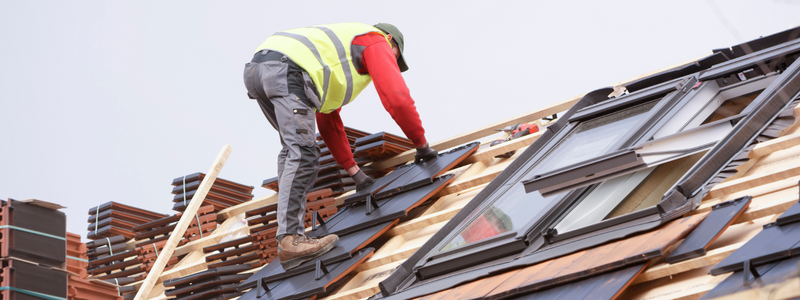
How to Select the Best Roofing Company in Denver
Just because a roofing company is one of the best in Denver does not mean they are the right fit for you. So how do you select the best roofing company for your needs?
Here are some helpful tips:
- Research the company online and check past client reviews
- Speak to your neighbors and ask them the company that handles their roofing job
- Visit the company’s website to familiarize yourself with their services
- Find out the company’s years and level of experience
- Compare prices with other roofing companies in Denver
- Interview the roofing company and stay objective
- Check to see if the company has a free estimate system
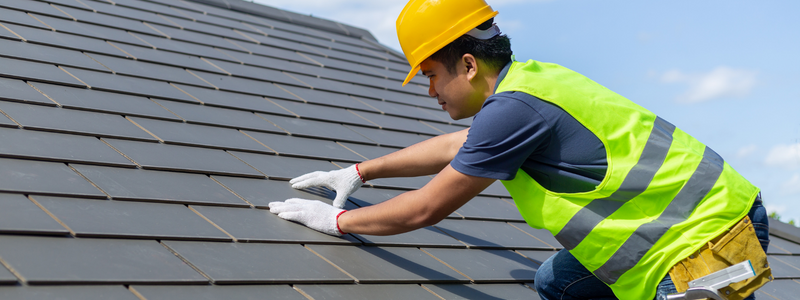
Trust B&M Roofing With Your Roofing Needs
At B&M Roofing, we are committed to rendering top-notch services to all our residential and commercial clients. We are available all year, whether you need repairs, installations, or replacements. So, request a free estimate today!
How Colorado Weather Affects Roofs
Colorado weather is tough on roofs. Between the large temperature fluctuations throughout the year, damaging storms, and the mile-high sun, Colorado weather affects roofs in several ways. These can significantly shorten their lifespans.
The lifespan of Colorado roofs is shortened by weather conditions like sub-zero temperatures, blistering heat, hail, heavy snows, torrential rains, and high winds.
Colorado Weather and Roofs
Colorado isn’t known for extreme weather, but our mix of blistering summer days and sub-zero stretches in the winter expose homes to extremes. Over time, that can take its toll on roofing materials. So watch for extreme weather events to damage your roof, and inspect it if you fear it suffered weather damage.

Ultraviolet Radiation:
- Colorado’s most extreme weather condition is present every day of the year. Just like it’s easier to get sunburned in Colorado, it’s easier for the sun to damage your roof. With fewer ultraviolet rays filtered by the atmosphere, your roof soaks up more of the UV rays that degrade it. Expect your roof to deteriorate faster than similar conditions at sea level.
Humidity:
- Humidity, or the lack thereof, can also affect your roof. When coupled with the sun’s harsh glare, our dry air can accelerate the decay of asphalt and shake shingles.
Summer Storms:
- The Front Range and Eastern Plains are both known for sudden blasts of extreme weather. These storms frequently generate 60-mph winds and hail. Storm damage isn’t always immediately visible, so call a qualified inspector or estimator to look closely at your roof after a storm.
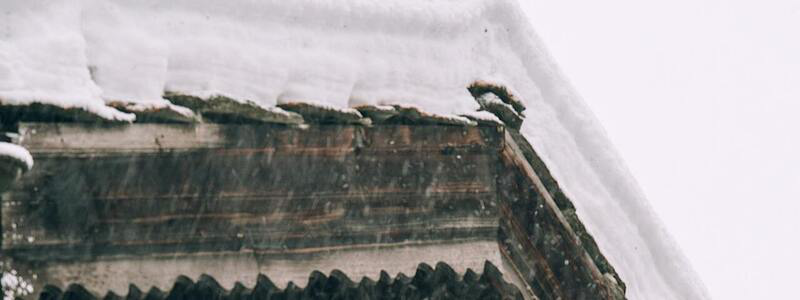
Ice:
- Our warm winter days are great for melting driveways. Still, the resulting overnight freeze can damage roofs when they don’t feature adequate drainage. Poorly draining rooftops – including roofs with gutters clogged with debris – lead to ice dams, which can damage roofing.
Snow:
- More of an issue in the high country than along the Front Range; the weight of snow can damage your roof or the home underneath it. Correctly pitched roofs will usually shed most snow. However, removing snow from your roof may be necessary when accumulation is particularly heavy or wet.
Colorado weather affects roofs all year long. If you fear your roof is succumbing to the climate, call B&M Roofing of Colorado today at 303.443.5843 or use our Free Estimate request.
Range of Roof Life in Colorado
Many things factor into your roof’s lifespan. At B&M Roofing, we estimate a Colorado roof will last between fifteen and thirty years. Manufacturer’s warranties may be anywhere from thirty to fifty years. However, these estimates depend on things like temperature extremes, weather conditions, and maintenance.
The type of roofing material is also a factor. Asphalt shingles, for example, do better in colder climates than in tropical heat.
Clay or concrete tile roofing is very durable and resilient. However, because they are so heavy, they must be installed on very sturdy roof structures. Clay or concrete roofs will last fifty to a hundred years.
The most durable roofing material is slate. It is expected to last a century or more.
Wood shingles have a lifespan of between twenty-five and thirty years if they are properly maintained. However, the roof must be kept free of moss and twigs so moisture is not trapped on the shingles. Fire is also a danger with this type of roof.
Cedar shakes are thicker than shingles. This means they are a good choice for Colorado’s intense heat and harsh cold winter weather. Wood shakes must be maintained to give them a lifespan of thirty-five to forty years.
Metal roofing is very resilient. Most metal roofing is steel or aluminum with a lifespan of fifty years. Copper or zinc roofing will last a century or more.
Why Get a Roof Inspection?
A new roof can prove pretty costly. But, with regular roof inspections, you can expect your roof to last longer. So, savings are significant.
Roof inspectors look for wear and tear on your roof. They can accurately estimate the life of your roof. They will make recommendations regarding necessary repairs. Certified roof inspectors can identify unsafe areas and poor-condition roofing. Roof inspectors will look at your roof’s internal and external components.
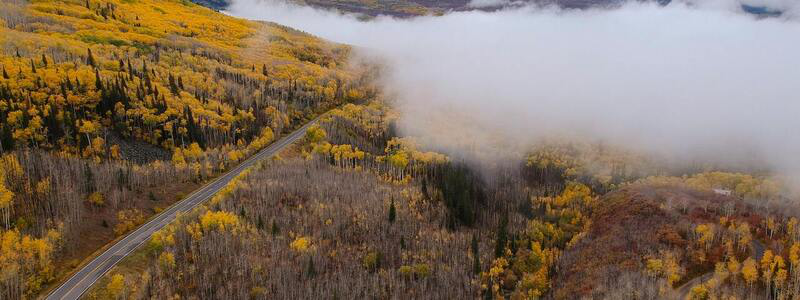
B&M Roofing Colorado: Colorado Extreme Weather
In Colorado, hail and snow storms are prevalent. They can cause a lot of damage to your roof.
At B&M Roofing, we inspect your roofs for the Colorado wheater and offer you durable materials to be used on your roofs. We will also provide you with preventive measures in the spring before the hail season.
Call us today at 303.938.9642 to schedule a visit from our emergency repair team, or visit our leak repair request page to submit your information and have one of our team members contact you.
Our 24/7 support line is here to help immediately with emergency roof repair. Calling sooner means less of a wait and more opportunities to repair before extensive damage is done. We offer work throughout Colorado, including:
- Denver
- Colorado Springs
- Fort Collins
- Boulder
- Greeley
- Rocky Mountain areas
- Surrounding states, including Wyoming, Utah, Kansas, Nebraska
How to Inspect Your Roof for Hail Damage
Summer in Colorado oftentimes means late afternoon thunderstorms and hail. While pea-sized hail is unlikely to do any damage, hail 1” in diameter (quarter-sized) and larger can be detrimental to your roof. If you’ve recently had a storm roll through your area with decent-sized hail, you may be curious to know if there was any hail damage to your roof. Depending on the extent of the damage, you may need some repairs.
There are a few things you need to think about before assessing your hail damage roof. Firstly, you need to ensure that you are safe. That is why hail damage roof assessments are often left to experienced professionals. Secondly, you must know there may not be damage to just your roof, but also to gutters and downspouts. That’s a good place to start when assessing the damage. It’s important to check roof elements such as chimneys and roof vents, as well.
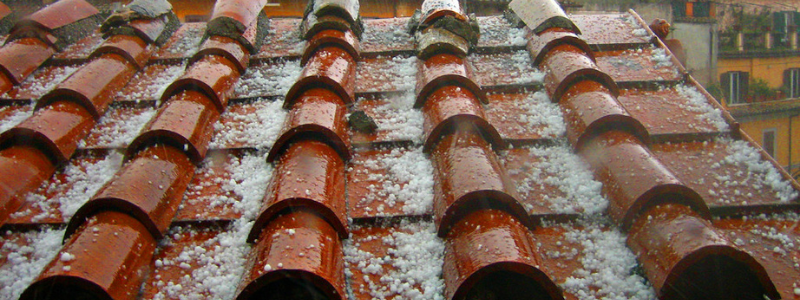
What Hail Can Do to Your Roof
Hail can do a lot to damage your roof. Not only can it damage the roof itself, but it can also damage roof elements like vents, chimneys, skylights, gutters, and more. A hail damage roof can be compromised depending on the extent of the damage. Hail damage to your roof can cause things like:
- Loss of protective shingle granules
- Cracks in shingles
- Exposed sub-surface materials
- Weakened seals
All of these things can lead to leaks in your roof, or worse. That’s why it’s important to be on top of the damage so that you get it assessed and repaired before it becomes a major issue.
Inspecting Your Roof for Hail Damage
Once you understand what hail damage can look like and the effects it may have on your home, you can start to inspect your hail damage roof. However, if you are uncertain about the safety of your inspection or are unsure how much damage was caused, it’s a good idea to call a professional. Here is how to inspect your roof for hail damage:
Safety First
Before you get up on your roof, we want to remind you that safety should be your first priority. Plan on wearing soft-soled shoes or roofing boots for safe walking on your roof. Always check that your ladder is in perfect working condition and bring some chalk to mark up any damaged areas. Never go up on your roof alone, always have someone outside with you!
Start With Obvious Damage
By looking for damage to gutters and downspouts, you can bet that your roof sustained some damage, too. Make your way around your home to take inventory of damage on some of those items. You may also look for damage to window sills, siding, and even your air conditioner.
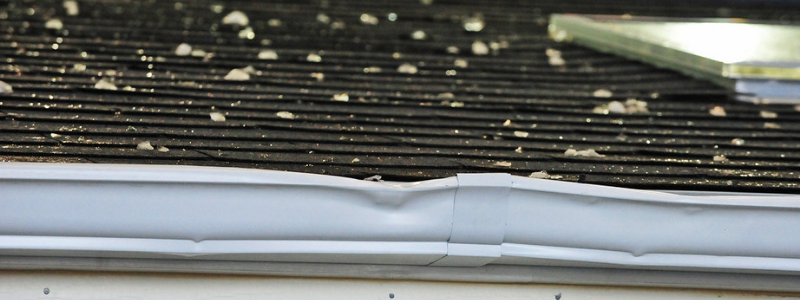
Inspect the Roof Features
Once you’ve inspected damage around the roof, it’s time to get on the roof. In addition to the roof itself, it’s also important to inspect roof features on your hail damage roof that may have also been impacted. Check all of the features that could have sustained damage, like roof vents, chimneys, and skylights.
For hard to inspect areas like chimney covers, or other places where the damage isn’t obvious, there is an easy solution. Bring a stick of chalk up to the roof with you. Turn your chalk sideways and run it over the surface. This will show you where there are dents and divots, thus uncovering hail impact points.
Inspect the Shingles
Hail damage to shingles isn’t always completely obvious. Figuring out the extent of the damage usually takes a trained eye. However, if you are choosing to inspect the damage yourself, here is what to look for:
- Obvious dents or divots
- Random round impact areas
- Dark-colored circles
- Areas where granules have been knocked off the shingle
If granules have been knocked off a shingle, this means that the hail has compromised the integrity of the shingle. This can cause leaks can develop over time. Circle each impact spot that you find with chalk to keep track of the extent of the damage.
When to Call a Professional
It is important to understand that roof inspection and repair are not things that can always be safely and easily done by anyone. Roofing professionals are trained and experienced in inspecting damaged roofs, assessing the damage, and coming up with an appropriate plan for repair. Whether a single shingle is damaged, or the entire roof and its features have been compromised by hail, it’s best to leave the assessment to experienced professionals.
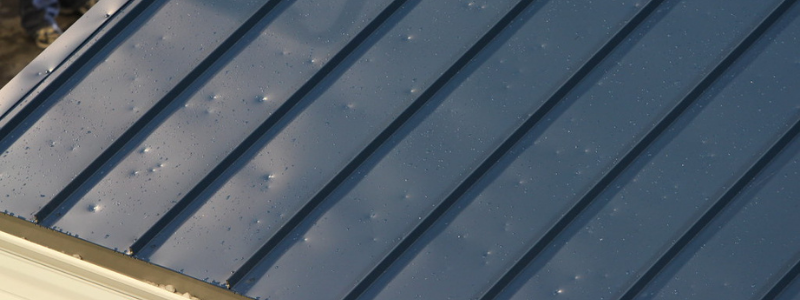
How B&M Roofing Can Help
B&M Roofing has been in the business of repairing roofs since its inception in 1947. We specialize in roof analysis, leak identification, preventative maintenance, repair, and more. We even offer emergency repairs for when your roof has been seriously compromised by harsh Colorado storms.
Once you’ve done some hail damage inspection of your own, it’s time to call in some experts to take a second look to determine what your next step will be. The roofing experts at B&M Roofing are happy to provide you a free estimate after a hail storm. You can contact us by calling or by submitting a free estimate request online!
